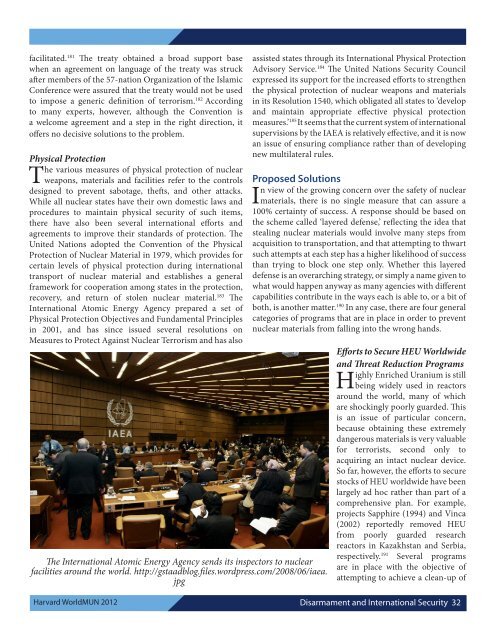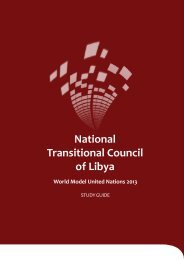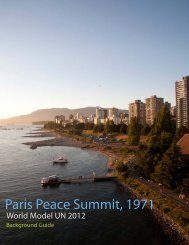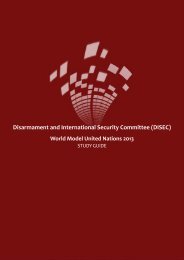Disarmament and International Security - World Model United Nations
Disarmament and International Security - World Model United Nations
Disarmament and International Security - World Model United Nations
Create successful ePaper yourself
Turn your PDF publications into a flip-book with our unique Google optimized e-Paper software.
facilitated. 181 The treaty obtained a broad support base<br />
when an agreement on language of the treaty was struck<br />
after members of the 57-nation Organization of the Islamic<br />
Conference were assured that the treaty would not be used<br />
to impose a generic definition of terrorism. 182 According<br />
to many experts, however, although the Convention is<br />
a welcome agreement <strong>and</strong> a step in the right direction, it<br />
offers no decisive solutions to the problem.<br />
Physical Protection<br />
The various measures of physical protection of nuclear<br />
weapons, materials <strong>and</strong> facilities refer to the controls<br />
designed to prevent sabotage, thefts, <strong>and</strong> other attacks.<br />
While all nuclear states have their own domestic laws <strong>and</strong><br />
procedures to maintain physical security of such items,<br />
there have also been several international efforts <strong>and</strong><br />
agreements to improve their st<strong>and</strong>ards of protection. The<br />
<strong>United</strong> <strong>Nations</strong> adopted the Convention of the Physical<br />
Protection of Nuclear Material in 1979, which provides for<br />
certain levels of physical protection during international<br />
transport of nuclear material <strong>and</strong> establishes a general<br />
framework for cooperation among states in the protection,<br />
recovery, <strong>and</strong> return of stolen nuclear material. 183 The<br />
<strong>International</strong> Atomic Energy Agency prepared a set of<br />
Physical Protection Objectives <strong>and</strong> Fundamental Principles<br />
in 2001, <strong>and</strong> has since issued several resolutions on<br />
Measures to Protect Against Nuclear Terrorism <strong>and</strong> has also<br />
The <strong>International</strong> Atomic Energy Agency sends its inspectors to nuclear<br />
facilities around the world. http://gstaadblog.files.wordpress.com/2008/06/iaea.<br />
jpg<br />
assisted states through its <strong>International</strong> Physical Protection<br />
Advisory Service. 184 The <strong>United</strong> <strong>Nations</strong> <strong>Security</strong> Council<br />
expressed its support for the increased efforts to strengthen<br />
the physical protection of nuclear weapons <strong>and</strong> materials<br />
in its Resolution 1540, which obligated all states to ‘develop<br />
<strong>and</strong> maintain appropriate effective physical protection<br />
measures.’ 185 It seems that the current system of international<br />
supervisions by the IAEA is relatively effective, <strong>and</strong> it is now<br />
an issue of ensuring compliance rather than of developing<br />
new multilateral rules.<br />
Proposed Solutions<br />
In view of the growing concern over the safety of nuclear<br />
materials, there is no single measure that can assure a<br />
100% certainty of success. A response should be based on<br />
the scheme called ‘layered defense,’ reflecting the idea that<br />
stealing nuclear materials would involve many steps from<br />
acquisition to transportation, <strong>and</strong> that attempting to thwart<br />
such attempts at each step has a higher likelihood of success<br />
than trying to block one step only. Whether this layered<br />
defense is an overarching strategy, or simply a name given to<br />
what would happen anyway as many agencies with different<br />
capabilities contribute in the ways each is able to, or a bit of<br />
both, is another matter. 190 In any case, there are four general<br />
categories of programs that are in place in order to prevent<br />
nuclear materials from falling into the wrong h<strong>and</strong>s.<br />
Efforts to Secure HEU <strong>World</strong>wide<br />
<strong>and</strong> Threat Reduction Programs<br />
Highly Enriched Uranium is still<br />
being widely used in reactors<br />
around the world, many of which<br />
are shockingly poorly guarded. This<br />
is an issue of particular concern,<br />
because obtaining these extremely<br />
dangerous materials is very valuable<br />
for terrorists, second only to<br />
acquiring an intact nuclear device.<br />
So far, however, the efforts to secure<br />
stocks of HEU worldwide have been<br />
largely ad hoc rather than part of a<br />
comprehensive plan. For example,<br />
projects Sapphire (1994) <strong>and</strong> Vinca<br />
(2002) reportedly removed HEU<br />
from poorly guarded research<br />
reactors in Kazakhstan <strong>and</strong> Serbia,<br />
respectively. 191 Several programs<br />
are in place with the objective of<br />
attempting to achieve a clean-up of<br />
Harvard <strong>World</strong>MUN 2012 <strong>Disarmament</strong> <strong>and</strong> <strong>International</strong> <strong>Security</strong> 32 32

















